Fourpines Therapy Dogs
We have recently embarked on a new journey. Serving others, through Therapy, with our Cavaliers. We are extremely excited about this new adventure. With health being our number one priority for our Cavalier King Charles Spaniels, temperament is a close second. Course beauty, structure, coat, lineage, etc are all very important to us, some would argue “Beauty is only skin deep”
As you guys probably know by now, if you’ve been reading through our web-site, we live in a very rural area, out side of town, on a ranch. It is approximately a 150 mile drive for us to get to the Dallas metroplex. This is where most of the therapy dog organizations are. Now that is not going to stop us! We will continue with our testing, observed visits, continuing ed, etc BUT we would like to bring these new found certifications and skills back to our hometown and more local. We have a wonderful adult care facility here in Graham, it’s where my grand-mother resides. We also have some special needs programs, schools, a nursing home and some other opportunities for therapy dog type services. ***We will absolutely be attending some wonderful activities and working at facilities and at the airport in “The City” occasionally as well.
Some of the first things you’ll need if you’re considering taking your new puppy through to a therapy or CGC title (or any training really) are…. a treat/training pouch and also –he will come to you already accustomed to– a clicker
I AM JUST DELIGHTED ABOUT THIS NEW ADVENTURE!!! AND THE CAVALIERS ARE SO EXCITED!!! — LAP DOG AND COMPANION IS WHAT THEY WERE BRED FOR AFTER ALL. THAT’S WHY THEY HAVE BEEN DEEMED “COMFORTER SPANIEL” . Now lets get to spreading Love, Joy, Smiles and Happiness with everyone.

The day Pippa passed her Alliance Therapy Dog test in Dallas Texas
For more information on the organization we are using visit here https://www.therapydogs.com/alliance-therapy-dogs/
They are a national therapy dog organization of whom AKC recognizes http://www.akc.org/events/title-recognition-program/therapy/organizations/
The group in the Dallas metroplex we are working with is http://www.hotthdogs.org/about.html (they are under the ATD umbrella)
Feeding Fourpines Cavaliers
We have taken the plunge!! We vow to only feed our dogs Canine approved, RAW, Biologically Appropriate Food from now on!! Certainly including RAW Goats Milk — ‘You shall have enough goats’ milk for your food, for the food of your household, and the nourishment of your maidservants’ (Proverbs 27:27).
I can not and will not tolerate all the nastiness from traditional dog food manufactures any more! All the dead, decaying, diseased, animals MOST leading dry/canned, dog food companies use in the process of making their dog food. All the additives and preservatives that I can not even pronounce, much less spell in order to research it so that I know what exactly I am giving our Cavaliers. We are done. We will source our food from here on out and we will know EXACTLY what we are feeding our dogs. There will be a VERY SHORT list of ingredients. Example: Chicken. Example: Venison. Period. Fact of the matter is, like the old British saying “Half the pedigree goes through the mouth” – you really are what you eat. No matter how fantastic a pedigree, it can be ruined by bad nutrition and bad rearing. Common sense prevails: Dogs need sunshine, exercise, and good, whole, hydrated food.
I realize I will have some critics. I realize not everyone lives on a ranch and sourcing RAW food for your dog can be a challenge. I realize not everyone’s life style or beliefs would allow you to feed your dog this way. I get it and it is ok. I simply will use this platform to do my best to educate why and how we feed our dogs. **Fourpines Cavaliers will work with each new puppy family individually and figure out what will suit each new home best. As always keeping the puppy and dog number one priority. If circumstances mean the puppy/dog will need to be fed kibble, we will trust Holistic Select or better yet, a “pre-made” balanced raw diet to be the best available option.
Now as far as the nuts and bolts of feeding our dogs, I’ll begin with a “simplified” explanation. We feed them chicken, beef, rabbit, turkey, pork, fresh free range eggs (with shell), venison, a few supplements, assorted vegetables, fats/oils, tripe, and home prepared bone broth. On occasion they get herbs, OFFAL, beaver, buffalo, a few varieties of fish, and maybe a few other things I have forgotten. THEY DO NOT GET EACH OF THESES EVERYDAY!!!! THE KEY TO SUCCESSFUL RAW FEEDING IS BALANCE OVER TIME!!! Ok lets take any particular morning of the week for example. I will set out everyones bowl, place 1 small chicken wing, approximately 1/4 lb ground beef, a TBS ground tripe, 1 (punctured and squeezed) vit E capsule, and 1/2 a tsp coconut oil into everyones bowl. Set the bowls down and everyone devours it!
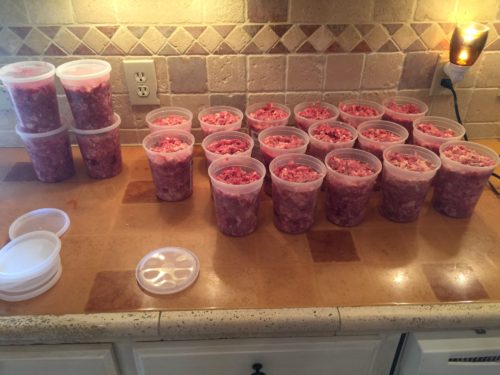
MEAL PREP DAY
The reasoning behind this particular diet.
Dogs were designed to eat raw food
We’re all aware that dogs evolved from wolves, however their gastrointestinal systems are still the same as they have always been, uniquely designed to digest prey – bones and all. Combined with seriously strong stomach acids, they can effectively eat a vast array of foods which could easily kill us humans.
Kibble was created for convenience, not with your dogs health in mind
Let’s face it, kibble is effortless. It lasts forever, creates virtually no mess, and takes seconds to serve a portion, so you can see why it’s everyone’s first choice when it comes to dog food. But what many people don’t understand is that kibble contains a high percentage of fillers such as grains, cereals, soy, corn, etc which our dogs haven’t evolved to eat.
By cooking the kibble during the manufacturing process, many proteins and amino acids are broken down leaving a bland product with very little nutritional value, and loads of sugars and starches.
Types of raw food diet
There are two main types of raw feeding, Biologically Appropriate Raw Food or “BARF” and Prey.
Biologically Appropriate Raw Foods – This is the method we mainly use
Also known as Bones And Raw Food, the BARF diet is a mix of raw meats, bones, fruits and vegetables to mimic what your dog would eat in the it’s natural environment.
The Prey model
Designed to imitate a dog’s natural diet as closely as possible, the Prey model takes BARF to the next level by feeding whole prey whenever possible. This includes whole rabbits, chickens, turkeys and many other small mammals that dogs would hunt or scavenge with their pack. This isn’t one for the faint hearted!
The health benefits of raw dog food
Healthier skin and shinier coat
With better quality food comes a much healthier dog, and it won’t take you long to notice a brilliant glossy coat, with naturally healthy skin underneath.
It’s not uncommon to hear of allergies, rashes or itchy skin and a host of other ailments clearing up after switching to a raw diet as kibble contains many fillers, cereals and grains which some dogs may be allergic to.
Improved immune system
Raw feeding will normalise and strengthen a dog’s immune system. The perfect balance of raw meat and bone will provide all the essential proteins, fats, calcium and minerals that your dog needs.
Leaner, more muscular physique
A raw diet will lead to increased muscle mass and reduced body fat making your dog appear more lean and healthier. This in turn leads to an elevated metabolic rate, greater energy levels, and less strain on hard working joints.
Healthier teeth, gums and breath
The scrubbing, flossing and massaging action of chewing on raw bone leads to naturally cleaner teeth and gums. A cleaner mouth also leads to cleaner breath and you’ll go much longer between teeth cleaning sessions compared to dried food. Some raw feeders literally never NEED to have their dogs teeth cleaned in their entire lives.
Improved stools
Are you tired of picking up sloppy dog mess? Well things are about to change. The improved health of the dog will introduce many benefits here, you can expect smaller, firmer, lower odured stools as your dog is able to absorb much more of the food compared to dried food. *Our dogs go on average once a day, a very small amount. AND the small amount of waste that is eliminated, is literally absorbed into the ground within days.
These are just a handful of the many benefits of raw feeding, with that in mind, why are you still feeding kibble?
Take your vets advice with a pinch of salt
Raw feeding is invariably a controversial topic in the vets office. Many vets are opposed to the practice of raw feeding and will often advise against it, but you have to take their opinion with a pinch of salt. Pet food companies provide financial support for trainee veterinarians, which gains them a certain bias. On top of that, vets will earn a commission on any pet food sold at their surgery. It is also worth bearing in mind that healthier pets mean less visits which leads to less revenue for your local vets surgery. Although the majority of vets share this opinion, vets are slowly taking the concept of raw feeding on board, we certainly hope this trend continues in the future. – Rawdogfood.co
ALRIGHT NOW YOU SAY “WHERE DO I BEGIN”
Lets take it slow. We to have been first time “raw feeders” and we understand it can be, and IS, an extremely scary, daunting task. We’ll begin with weaning.
Our puppies are weaned from mom onto raw, organic, locally sourced goats milk. We put the room temperature milk in a small shallow dish into the dams whelping box for her to lap up and the puppies to begin watching and learning from her at around 3 weeks. After a few days of this we will add a very small amount of VERY finely ground venison OR beef. Slowly over the next 7-10 days, balancing the milk to meat ratio to about 50/50. The following week the meat will be a little less finely ground and the ratio will be approximately 75% meat to 25% milk. This is about where we keep the puppies at for one of their 3 feedings a day until around 12 weeks old. By 5-6 weeks, meaty bones are also provided. These are great and should NEVER be COOKED. At 6 weeks we begin adding in eggs as well (once a week). From there you can start the process of adding different proteins and OFFAL. Remember when adding a new protein, give a sample, then feed that for 4-5 days before adding another protein. Of course we always provide fresh, clean water at all times. These are our very basic guidelines. Every puppy is different. Every litter is different. Every season is different. By the time puppies are around 6 weeks old we usually know which puppy/puppies we are keeping, which home each is going to and what they will be fed in the future and we work around all of these factors.
OK This first one is one of my favs!
http://perfectlyrawsome.com/dogs/raw-feeding-puppies/
Probably the best, most comprehensive “beginners guide” I’ve ever seen https://rawdogfood.co/wp-content/uploads/2014/11/raw_feeding_cheatsheet.pdf I believe it is in PDF format for you to print as well. PLEASE at least read this article if you are even the slightest bit interested in feeding your dog a raw diet.
Here’s a host of information about the benefits of Raw Goat Milk. It will give you a very good idea as to why we wean our babies onto it. http://www.roseofsharonacres.com/raw_goat_milk_benefits
Another good site with loads of information https://breedingbusiness.com/health/
HERE IS AN AMAZING OPTION!! This company will do EVERYTHING for you. They alternate proteins, include muscle meats, bones, organs, everything. Custom tailored, pre- measured for YOUR pet or pets. It will come frozen and labeled with the dog or cats name. The monthly pre-measured plan also ships for free! https://reelraw.com/pages/pre-measured-service
If you’re spending around $100.00 a month on dog food, this could be a really good option for you.
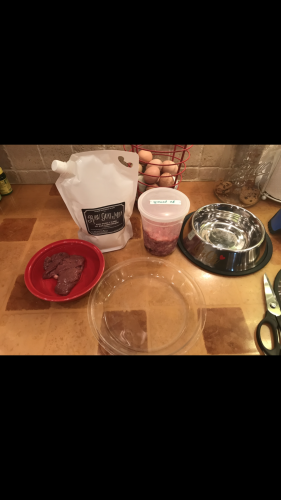
A typical meal for weaning/weaned puppies
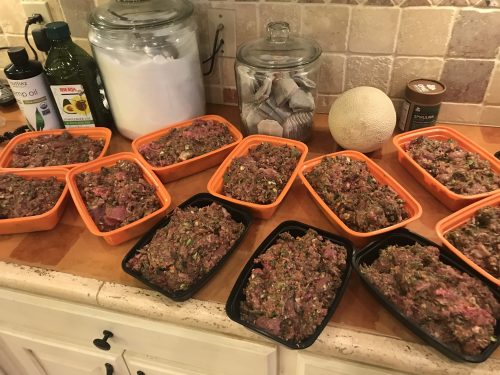
Prep Day
How much raw dog food to feed
You should aim to feed a varied and balanced diet over the course of a week or so, alternating different meats wherever possible. Of course after the initial “trying” each protein as discussed above.
The ideal combination of food types are:
Remember, these percentages don’t need to be exact per meal or per day, just a target for the week.
Dogs need to consume 2-3% of their ideal (healthy sized adult) bodyweight per day, usually split over two meals. This figure may be different from one dog to another as you will need to adjust for their current size and activity levels.
If your dog is overweight then feed 2%, likewise if you dog is too skinny, you may want to increase this amount to 3.5%. Start with a percentage and fine tune it over time.
The table below gives a rough feeding weight in both metric and imperial, this is based on 2.5% bodyweight.
| Weight in KG | Feed | Weight in lbs | Feed |
|---|---|---|---|
| 5kg | 125g | 10lb | 4oz |
| 10kg | 250g | 20lb | 8oz |
| 15kg | 375g | 35lb | 14oz |
| 20kg | 500g | 45lb | 18oz |
| 25kg | 625g | 55lb | 22oz |
| 30kg | 750g | 65lb | 26oz |
| 35kg | 875g | 80lb | 32oz |
| 40kg | 1kg | 90lb | 36oz |
| 45kg | 1.125kg | 100lb | 40oz |
Don’t forget that treats count towards the daily allowance so if you’re doing heavy training sessions, you may want to compensate during meal time.
Alright now lets talk about how to make the switch if you are feeding kibble but are fed up with kibble for what ever reason and would like your dog to be on a better, healthier, less expensive diet.
The best way to switch your dog onto raw food is to just do it! a.k.a. cold turkey. Stop feeding your dog kibble one day, then start on raw food the next morning. This is exactly what we did. You can introduce a “fast” day in between if you like to help clear the dogs system of kibble. Fasting will not harm your dog, in nature dogs are used to going a day or two without food after an unsuccessful hunt.
Please don’t be tempted to mix kibble in with the raw food, you’re best off sticking with 100% raw. Meat and kibble are digested at different rates which isn’t ideal for your dog.
For the first week or two, stick with one variant of food, a safe starter flavour is chicken. Mixing flavours so early on can lead to an upset stomach and unwanted trips to the toilet. Likewise, don’t introduce offal too early, it’s best to leave it 4-5 weeks then introduce it slowly. *refer to weaning puppies
If you already have a puppy or young dog, switching is the same process, perhaps even easier. Puppies love raw dog food, and will very easily take to it. Start puppies off with three meals a day rather than two until they are around 6 months old.
HANDY CHART FOR CONTINUING TO FEED YOUR NEW FOURPINES PUPPY RAW
The most accurate way is to feed an amount based on bodyweight percentage. The following table has been devised by Add Ridyard after studying several breeds over a period of time. I of course will be here to guide, help, educate and encourage you every step of the way.
| Age in weeks | % of bodyweight to feed |
|---|---|
| 7 – 10 | 8 – 10 % |
| 10 – 16 | 7.5 – 8.5 % |
| 16 – 20 | 6.5 – 7.5 % |
| 20 – 24 | 5.5 – 6.5 % |
| 24 – 36 | 4.5 – 5.5 % |
| 36 – 56 | 3.5 – 4.5 % |
| 56 – 68 | 3.5 % |
| 68 + | 2 – 3 % |
Continue splitting their daily amount into 3 meals per day. Once your puppy is 4 months old, look into changing this to 2 meals per day. Then around 9 months 1 meal a day. With one meal a day being the goal by it’s first birthday. All of our Cavaliers are fed 1 meal per day. They do all get treats throughout the day and of course their Nuvet and bedtime.
Remember, every dog is different and what applies to one may not apply to another. Dogs have different metabolic rates, activity levels, and breed requirements so bear this in mind.
Now that we have had and introduction and beginning to the basics of Feeding Fourpines Cavaliers, if you choose, you may go onto the next page “Raw Feeding” There you will find much more information including pictures, links, resources and guidelines for feeding your dog an actual healthy, canine appropriate, raw food diet.
For anyone wishing to read just a few articles on why I am so fed up with Traditional dog food. Here are a couple. I will be more than happy to supply you with hundreds more.
Exposing the truth, Ann Martin in her book “Food Pet’s Die For”, links the revolting practice and detection of sodium pentobarbital in dog food products. The reason this is such a controversial topic is sodium pentobarbital is linked to a veterinarian drug to euthanize pets!!!
According to “Food Pet’s Die For” By Ann Martin:
“At the rendering plant, slaughterhouse material, restaurant and supermarket refuse, dead stock, road kill, and euthanized companion animals are dumped into huge containers. A machine slowly grinds the entire mess. After it is chipped or shredded, it is cooked at temperatures of between 220 degrees F. and 270 degrees F. (104.4 to 132.2 degrees C.) for twenty minutes to one hour. The grease or tallow rises to the top, where it is removed from the mixture. This is the source of animal fat in most pet foods. The remaining material, the raw, is then put into a press where the moisture is squeezed out. We now have meat and bone meal.”
DISGUSTING
http://www.thedogdigest.com/dog-food-review/12-most-controversial-ingredients-found-in-low-end-dry-dog-food/
http://www.dogfoodadvisor.com/red-flag-ingredients/dog-food-preservatives/
http://www.thedogplace.org/NUTRITION/raw-meat-diet-debate_Henry-1412.asp
I will hesitantly add (again) way down here at the bottom for those that can not, will not, or choose not to feed their dogs a raw diet, I will work with you on what food and nutrition is best for your Fourpines Puppy.
Fourpines Puppies with their new Families
Here are some pictures of our Fourpines Cavalier puppies in their new forever homes with their families. Thank you to all who have adopted from us. We are so happy to have you as a part of our Cavalier Family. We will ALWAYS be here for you and your four legged Fourpines fur baby.
Our babies stay with us until at least 10 weeks of age. They will have had 2 complete exams with a DVM, their first set of age appropriate vaccines, been wormed with Nemex2 at 3, 5 and 8 weeks of age and will be micro-chipped with AKC REUNITE INDI MINICHIPS. Puppies leave AKC registered (I will have all paperwork filled out, you will decide options, add your personal check, and I will mail) They will also have a puppy blanket with dam and liter mates scent on it, a small bag of food they’ve been eating, a toy, copy of our contract, and nuvet sample and brochure. We put 100% of our heart and soul into the puppies we breed. Your puppy will be litter trained and have been started potty training out doors. We will do everything in our power to ensure your puppy is happy, healthy and well socialized. If you would like to continue the puppy culture way of raising your cavalier *and I HIGHLY RECOMMEND IT I’d say check out all the information on the PC web-site
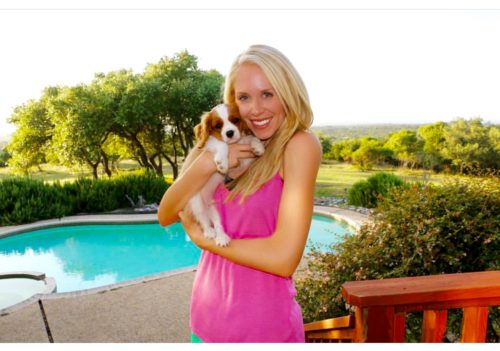
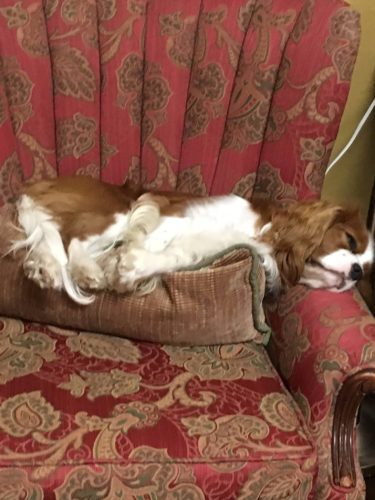
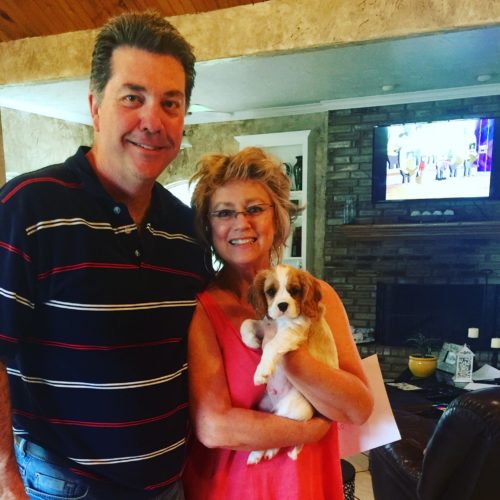
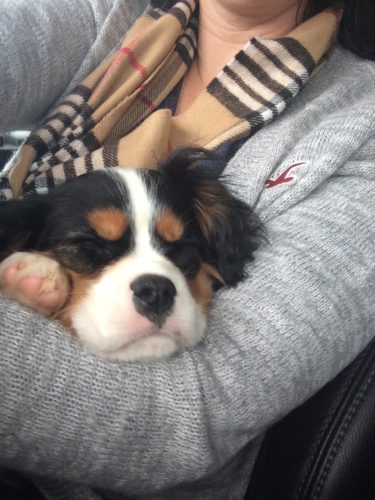
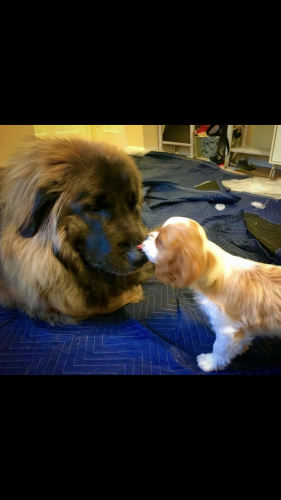
Our sweet Charlie meeting his new big brother Balio The Leonberger
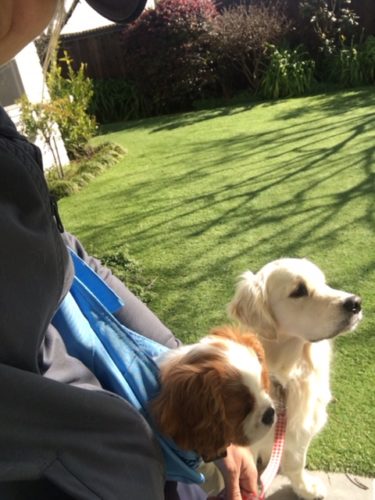
Little Chip with his new big sis Triscuit the beautiful golden retriever

A collage of the pick up days for Sophia’s first litter going to their new homes. One family came to our home. We met one family at DFW airport and met a mom at a nice dog friendly restaurant in Weatherford Tx.
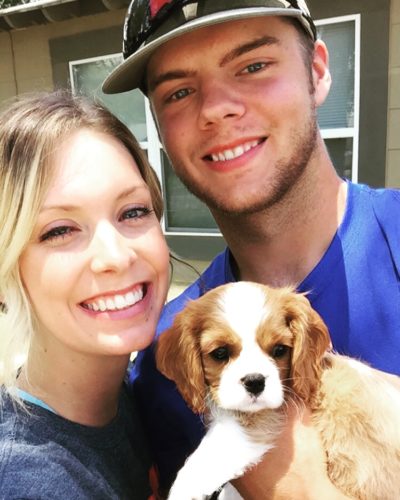
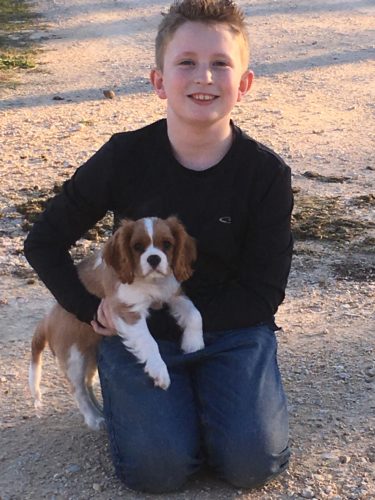
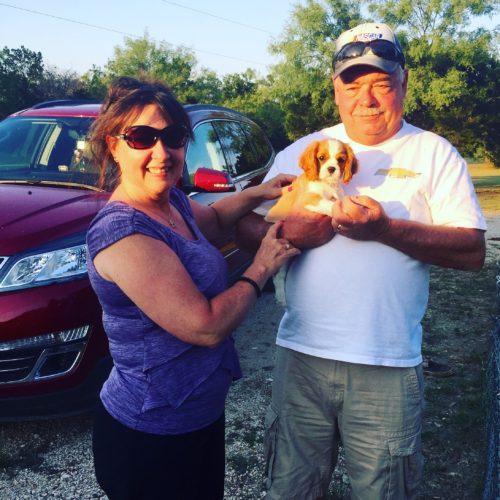
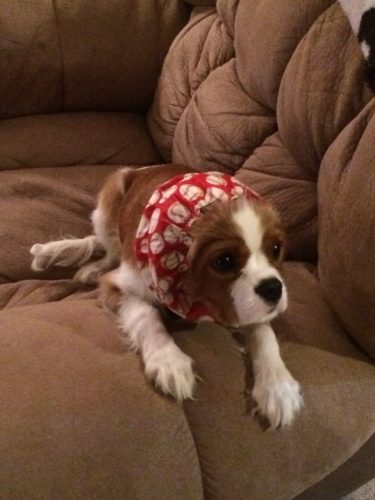

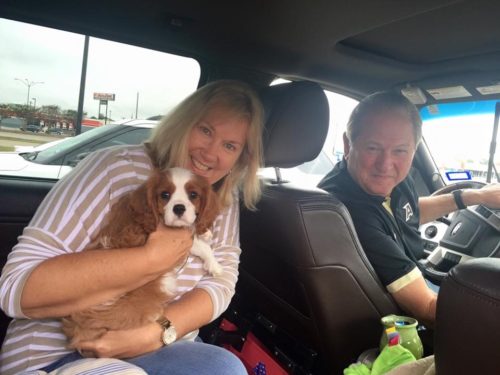

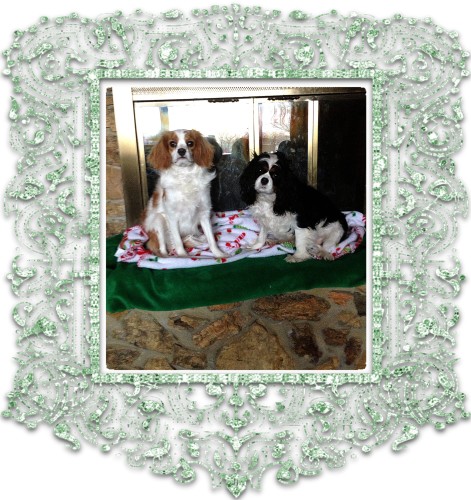
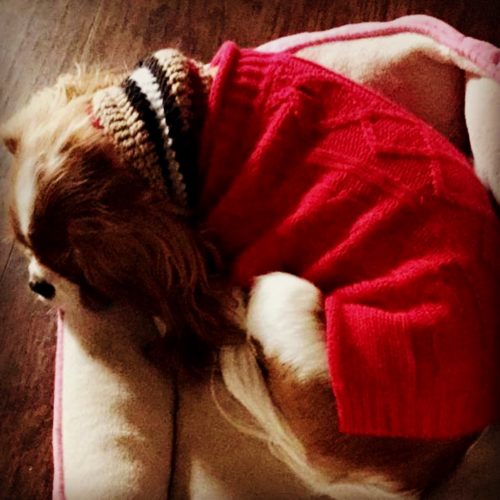
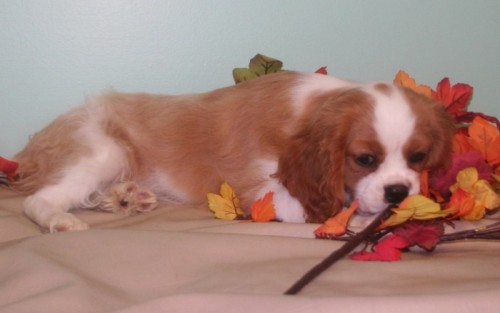
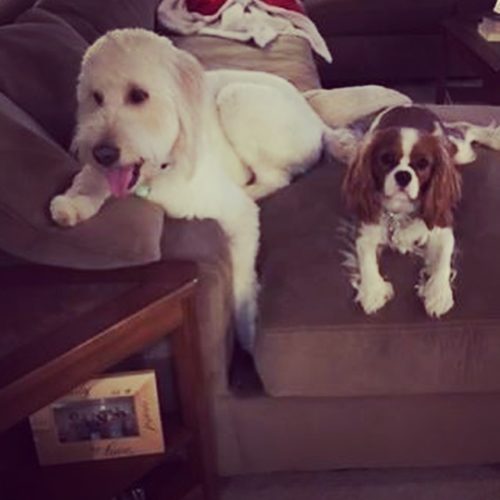
Sweet Cooper with his older “cousin” Max
Hopefully you are anxious to get your new puppy socialized, exercised and ready to see the world. Your #1 priority needs to be the safety and well being of your new Fourpines Cavalier. We strongly recommend taking the most extreme measures of keeping your new puppy from deadly diseases until their vaccinations are complete and your DVM has affirmed they are protected from Parvo, distemper, etc. WE DO NOT RECOMMEND ANY PUBLIC “DOG PLACES” UNTIL THE ENTIRE SERIES OF INOCULATION IS COMPLETE!
For at home activities and exercise and for AFTER your puppy has had his/her completed series of vaccinations, here is a great exercise guideline. Please don’t forget, your puppy is very young. They are just babies. Don’t let them walk to far at a time
EXERCISE ARTICLE W/GRAY BACKGROUND SIZE 250PX WIDE
“>http://<script type=”text/javascript”>document.write(“<iframe name=’banner’ src=’https://puppyculture.postaffiliatepro.com/scripts/banner.php?a_aid=5aba6d262cf96&a_bid=075ffc84&w=1&refx2s6d=”+encodeURIComponent(encodeURIComponent(document.URL))+”‘ framespacing=’0′ frameborder=’no’ scrolling=’no’ width=’250′ height=’189′ allowtransparency=’true’><a href=’https://shoppuppyculture.com/collections/books-1/products/second-edition-puppy-culture-exercise-booklet’ target=’_top’>EXERCISE ARTICLE W/GRAY BACKGROUND SIZE 250PX WIDE</a></iframe>”); </script> <noscript> <h2><a href=”https://shoppuppyculture.com/collections/books-1/products/second-edition-puppy-culture-exercise-booklet”>EXERCISE ARTICLE W/GRAY BACKGROUND SIZE 250PX WIDE</a></h2> </noscript>
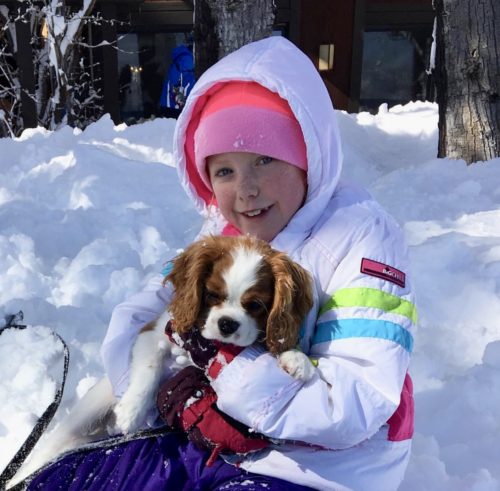
Fourpines Cant Have Just One “Chip” with his sweet sister in Lake Tahoe
Raising Fourpines Puppies
This page will be an ongoing collaboration of the Fourpines puppies we’ve bred and raised. As we stated on our litters page, we implement Jane Killion’s Puppy Culture in the raising of our puppies. We love everything about Jane’s way of thinking and the educated, reasoning behind why she teaches the way she does. This page is dedicated to the first “graduation” of our litters. When we move them from the “nursery” which is our master bedroom, at around 3-4 weeks of age, to the family room where they really begin learning to become an important, well mannered, member of the family. It will also include some of the socialization we do with our puppies along with links to some amazing articles written by pioneers in the dog world. From the first hurdles to manding to entering a crowded place and the dog never takes his eyes off of you. Your dog is an eager to please, learning, sponge. There is nothing we will not do to insure Fourpines Cavaliers the best life possible. We believe this absolutely must start with the breeder. Then of course the new puppy parents. If you have not heard of Puppy Culture please take the time to research it. We would love nothing more than all our puppies to go to PC homes. Heres the home page for you to begin researching and getting to know exactly what we do with our babies. AND we also use the Sound Proof Puppy Training App.
Starting at a very young age, our puppies listen to many many sounds such as babies crying, sirens, lawn mowers, fireworks, thunder strorms, and so many more. This of course is in addition to all of the noises in our home on a daily basis.
We have some form of “A Alexa” in basically every room of our home. For music, video, talking to the pups or their moms, everything. Welcome to 2021. haha And this is. the crate we use (DOOR REMOVED) for beginning crate training. I just get the plastic. ball pit balls off amazon and throw away & replace as needed. They’ve always been a big hit.
We undoubtedly have used a ton of different puppy pens. Plastic, metal, pvc, homemade, store-bought, etc etc etc. Our favorite is this one. We have added to, taken away from, moved with, sectioned off areas and kept dogs, puppies and rabbits safe with lots of company, holidays, vehicles and equipment moving around indoors and out for years with these.
We like this small, portable one for travel and this inexpensive one four temporary circumstances with small/young pups.
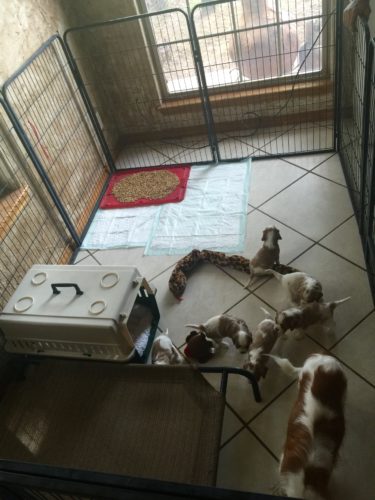
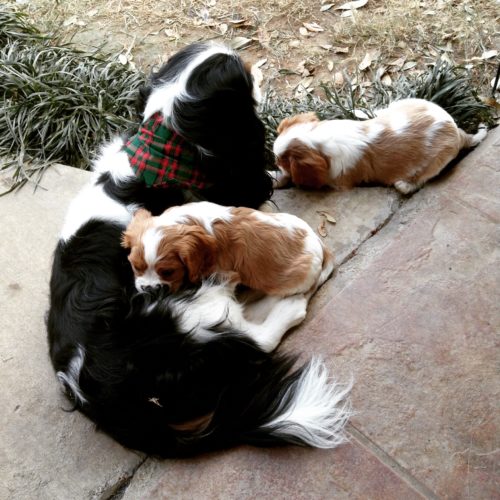
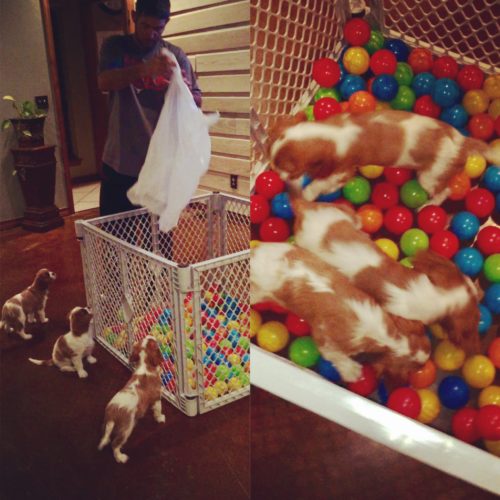

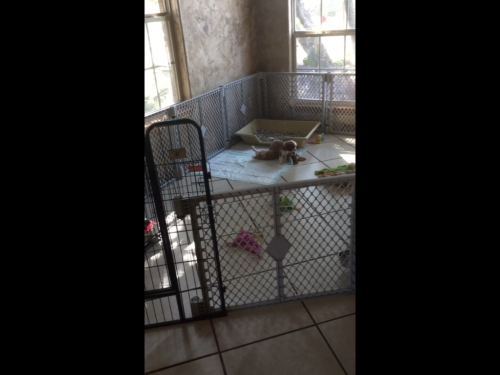
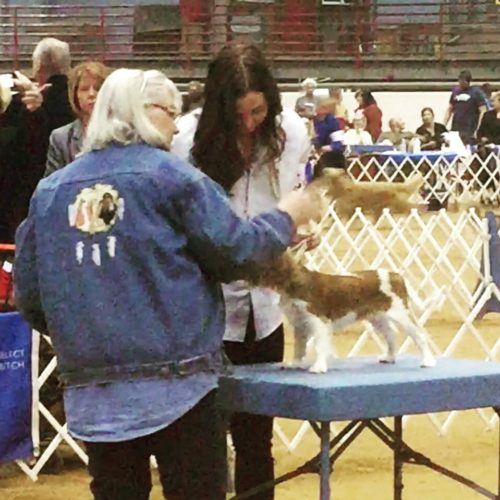 Wonderful information on early preparation of the best little show puppies around. So much fun here’s a link to
Wonderful information on early preparation of the best little show puppies around. So much fun here’s a link to
Attention 160×600 PX
“>watch


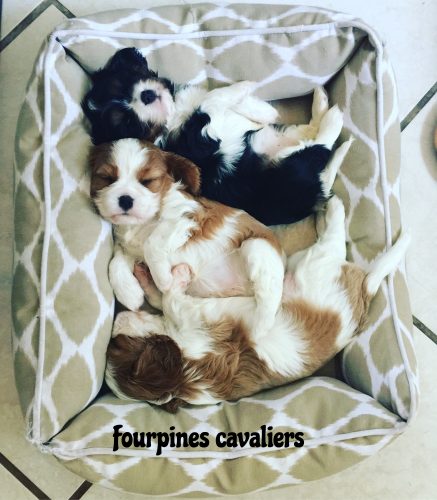
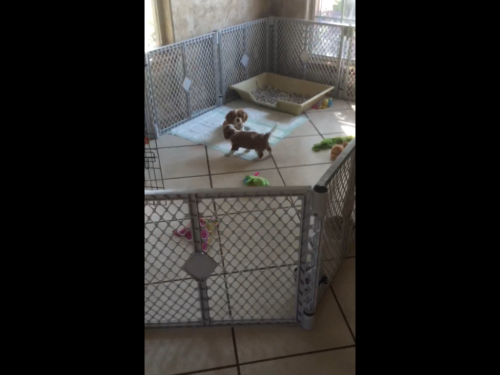
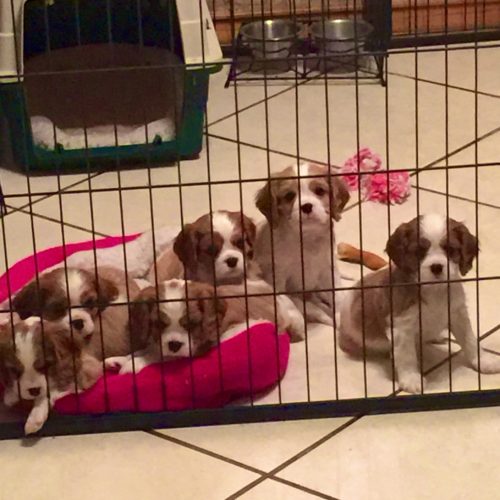
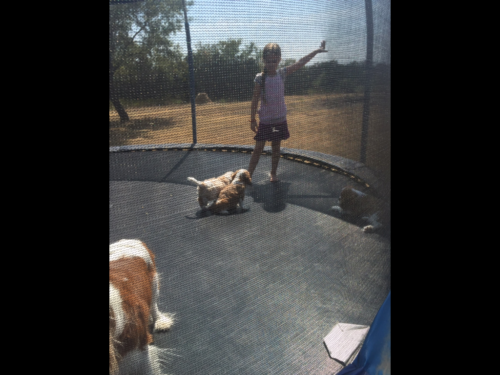
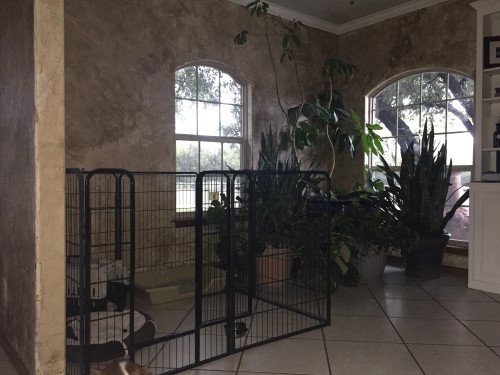
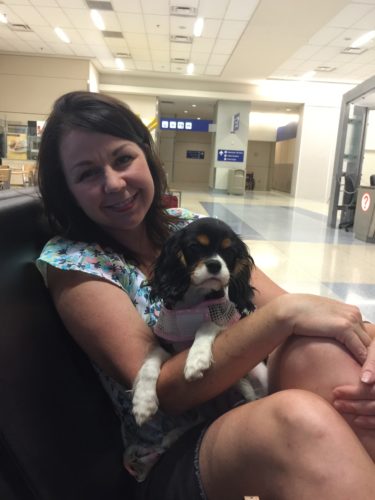
At DFW airport waiting on our oldest daughter to arrive home from Jamaica
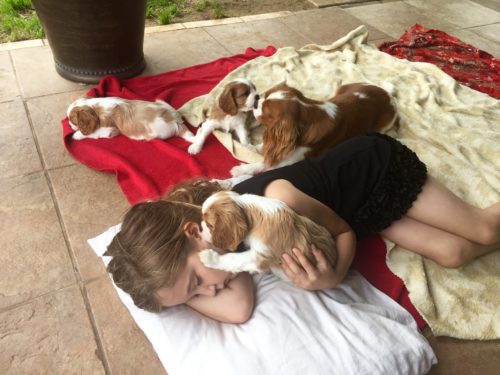

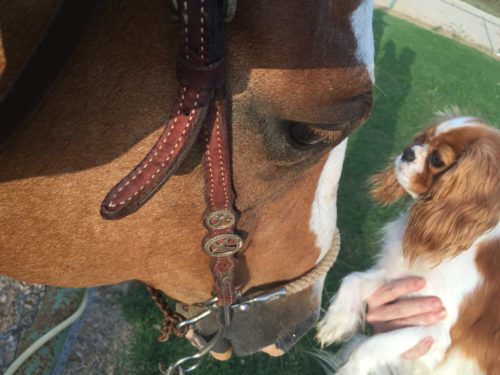
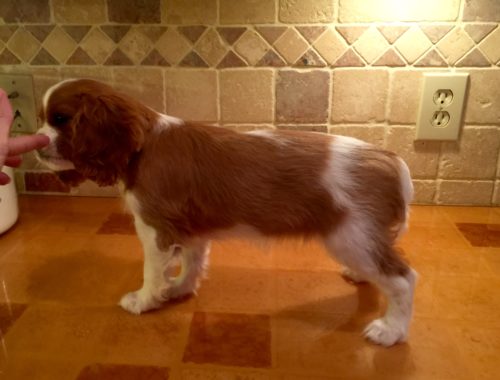
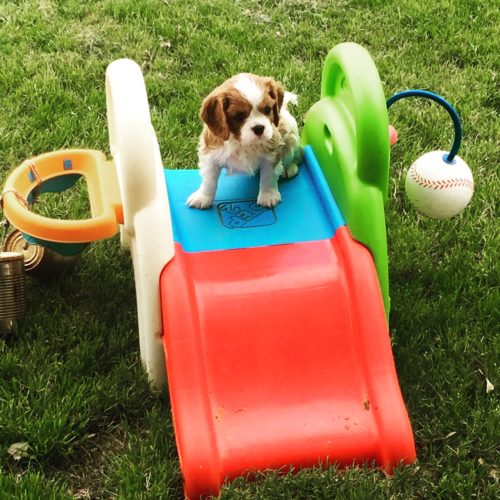

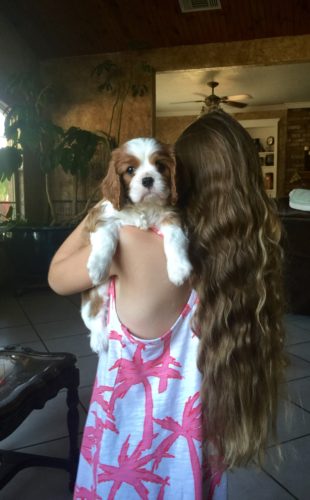
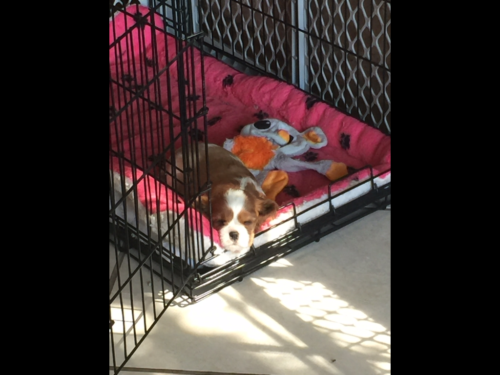
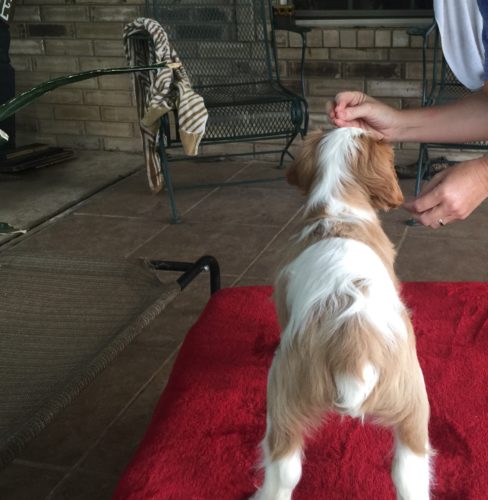
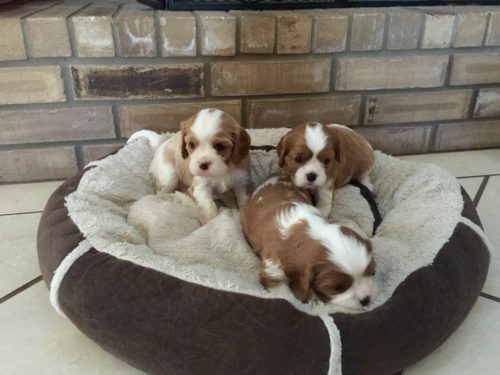


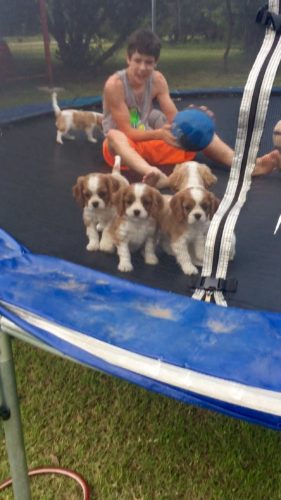
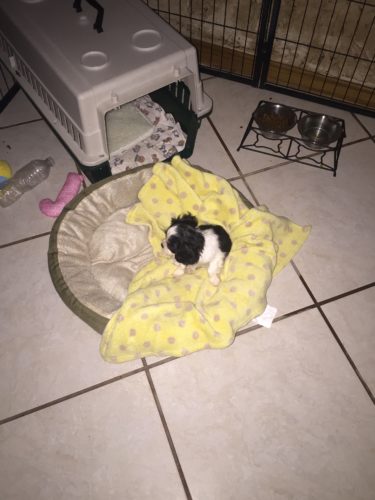



Meeting Chickens
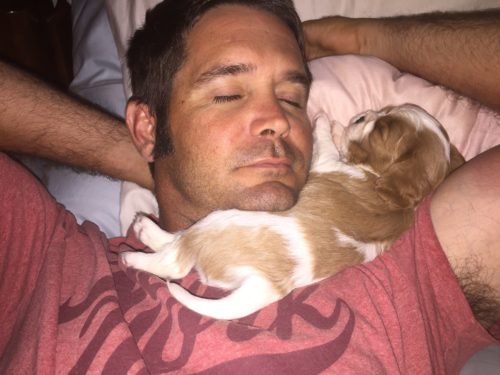
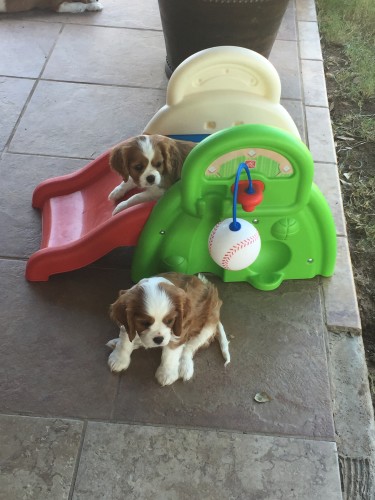
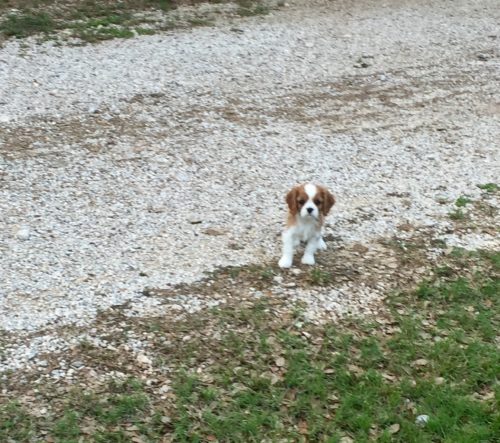
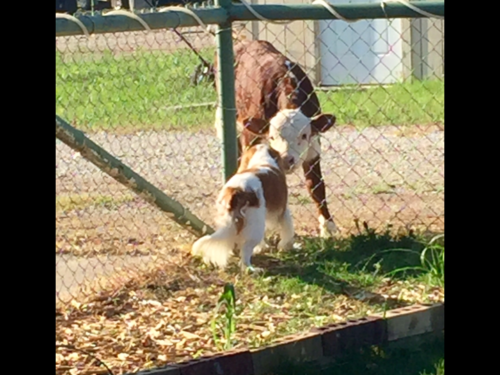
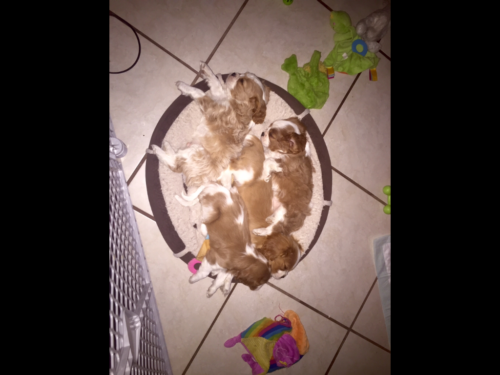
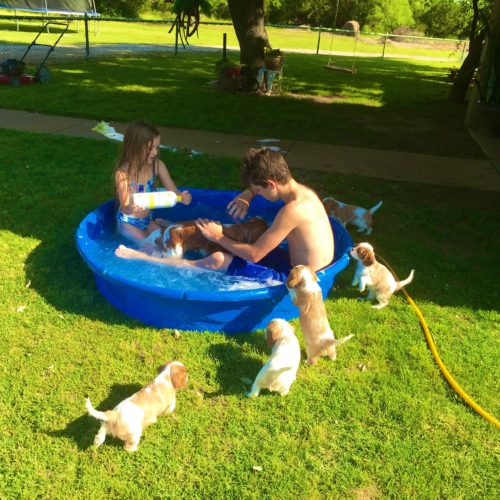
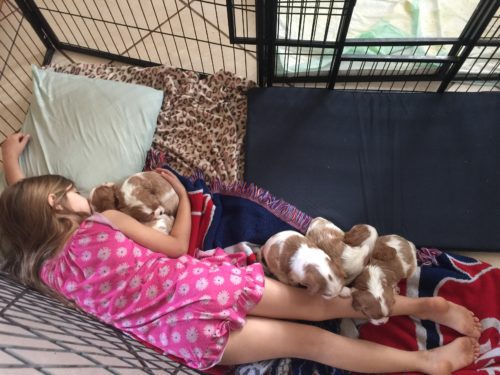
We hope through photos we can tell the tale of a day in the life a our Fourpines Cavalier puppies.
When they are moved to the family room and begin weaning from their dam, the are also introduced to a crate (door removed) a potty area (we use 100% pine pellets in their litter box) many novel objects changed daily, food other than moms milk and all the sights and sounds of a families daily life with other dogs/animals and children. Once we feel they are ready, it is safe and weather permitting, we begin taking them outside. We have a small fenced in area for them to begin exploring and pottying in grass outdoors. *The ultimate goal of course is for all dogs to be 100% accident proof in the house. I can not guarantee your puppy will come to you at 10 weeks old fully potty trained, but what I can say is we spend lots of time going in and out and rewarding their efforts starting at a very young age.
They also will begin “Manding” It is simply teaching a puppy a way to ask for things from people. A way that is preferred over jumping up on you and barking and crying out. What we are wanting them to do is sit quietly when a human person approaches the pen. Sit to be pet, sit to be fed, sit to get out, etc. This is one of the first things Jane Killion teaches people to teach their puppies in her puppy culture videos. It is very important for everyone in your household to understand and be on board with these basic initial steps. They catch on so quickly and are very happy to get what they want, once they “asked” for it. The best part is….. You never have to say a word. You simply wait until they sit (which is asking for what they want) 1 of the best PC (puppy culture) DVD’s to begin with, if youre not wanting to invest in them all is “Attention is The Mother” It is jam packed full of wonderful information for teaching and training your puppy in a positive way. You can order it here
ATTENTION COVER ONLY 175
“>http://<script type=”text/javascript”>document.write(“<iframe name=’banner’ src=’https://puppyculture.postaffiliatepro.com/scripts/banner.php?a_aid=5aba6d262cf96&a_bid=386a2b18&w=1&refx2s6d=”+encodeURIComponent(encodeURIComponent(document.URL))+”‘ framespacing=’0′ frameborder=’no’ scrolling=’no’ width=’170′ height=’239′ allowtransparency=’true’><a href=’https://shoppuppyculture.com/collections/buy-dvds/products/demand-to-win-puppies-attention-is-the-mother-of-all-behaviors’ target=’_top’>ATTENTION COVER ONLY 175</a></iframe>”); </script> <noscript> <h2><a href=”https://shoppuppyculture.com/collections/buy-dvds/products/demand-to-win-puppies-attention-is-the-mother-of-all-behaviors”>ATTENTION COVER ONLY 175</a></h2> </noscript>
We (ADULTS ONLY) always take our litters on car rides and occasionally take them (individually) on our Polaris/ATV.
They see our local vet for a quick well-ness visit usually around 6 weeks. Oh how they love our Cavalier puppies!! Then we take them for a more extensive visit with our DVM and to start vaccinations at 9 weeks. We follow Dr Jean Dodds vaccination protocol and recommend but do not require you to continue this advise. ALWAYS follow the advise of your DVM. There are different risks and diseases in different areas of the country and it is very important to listen to your own vets recommendations and do your research about your new puppies health, well being and vaccinations.
http://breedingbetterdogs.com/article/early-puppy-training
HEALTH
The health, well being and longevity of our Cavaliers is our #1 priority. All of our breeding dogs are, at the minimum, tested annually for MVD (hearts) eyes and patellar.
Please NEVER hesitate to contact me with any questions or concerns about your Fourpines Puppy. We will be here for your new Fourpines Cavalier King Charles Spaniel its entire life. That is a promise!
Years before we breed any of our Cavalier King Charles Spaniels we begin researching pedigrees. The lineage of our dogs is of the upmost importance to us. It tells us a wealth of information about the health and longevity of where our dogs have come from. The health of our dogs and the puppies we bred is our #1 priority. If you’d like to read an article about the importance of pedigrees and why we take it so incredibly seriously and feel you should to, you can click this link. It won’t take but a minute to read and you can learn so much from it. http://www.thedogplace.org/GENETICS/Reading-Pedigrees_BJA-133.asp
OFA
Website: http://www.offa.org
Currently there are 4 screenings recommended for Cavalier King Charles Spaniels: Heart, Eye, Patellar, and Hips
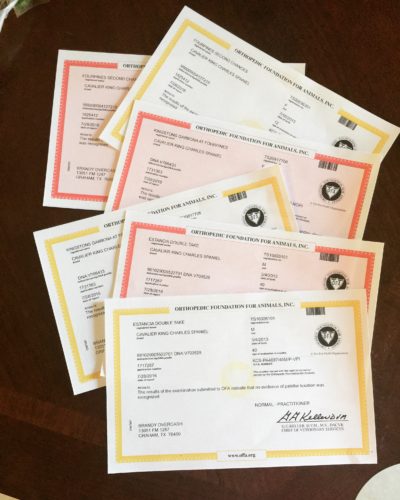
Some of our OFFA certificates (fall 2016) for our breeding Cavaliers
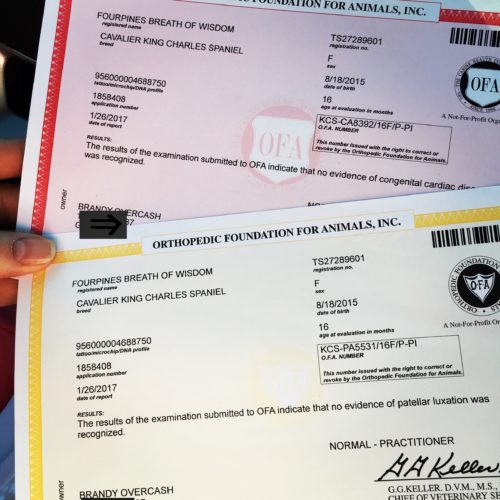
Our homebred girl Fourpines Breath of Wisdom’s first certificates from OFFA
Some of the things we use for hearts, teeth, brains, HEALTH of our cavaliers (sparingly after consulting with our DVM) are
ALWAYS #1 is our Nuvet Vitamins Our dogs and puppies go bananas for their daily “cookie” every single day!
Something else we use regularly are good quality oils. Like this salmon oil, this hemp oil and this organic coconut oil.
In addition to their daily RMB’s (raw meaty bones) we keep lots of simple/minimum ingredient chews on hand at all times. An absolute fav here at Fourpines is bully sticks. They go nuts for them. And these grain free, antibiotic free, hormone free water buffalo ear chews
Mostly for puppies but our adults like them too (they just eat them to fast) are pasture raised, organic Himalayan yak chews. Yum! 😉
Im sure you know by now that all of our dogs are exclusively raw fed. Our puppies are weaned to raw and that’s all we feed. So their main source of probiotics comes from the food canines have been eating for…….a million years. Especially fresh, raw, green tripe. BUT on the occasion, say we’re traveling or we need to recommend a probiotic to a friend that can not source tripe, id use this
|
Hip Displasia: includes OFA evaluation (prelim before 2 yrs, official after 2 yrs), OVC evaluation, and PennHip evaluation (anytime after 16 weeks of age through adulthood) Eye Clearance: Initial evaluation recommended at 8-12 weeks of age, follow up at 12 months of age, annually until 5 years of age, every 2 years until 9 years of age. Patellar Luxation: OFA evaluation at 12 months of age or older Congenital Cardiac Database: OFA evaluation with examination performed by Board-Certified Cardiologist. Recommended annually. CHIC Website: http://www.caninehealthinfo.org
|










